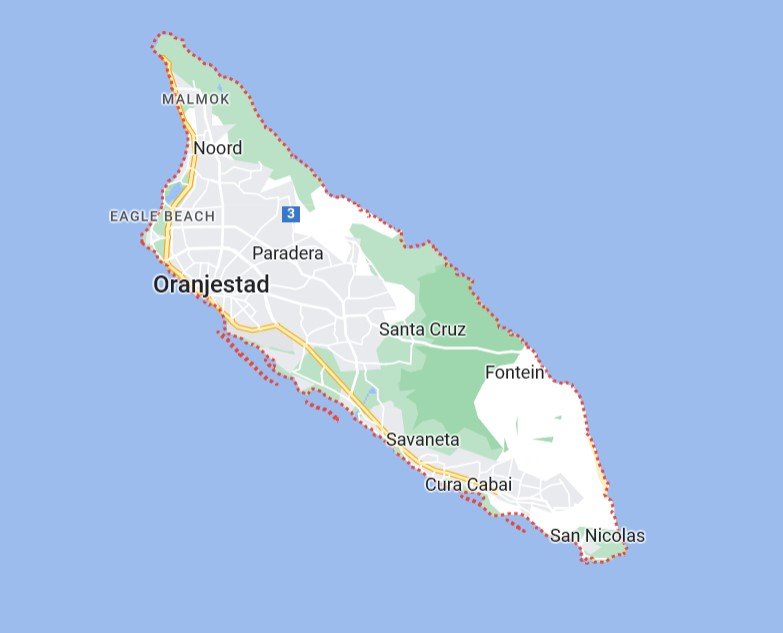Aruba
I recently took a walk with a Dutch-American friend and told her I had been to a meeting in Aruba. Right away she said—they speak Dutch there! Unlike my friend, most Americans associate the island of Aruba with the disappearance of Natalee Holloway in 2005 who was visiting the island as a tourist. Dutch-Americans were probably more attentive to the fact that one of the suspects associated with her disappearance was a Dutch citizen. That suspect, Joran van der Sloot, was recently extradited from a Peruvian jail to the US to stand trial for extortion related to her disappearance. Dutch, tourism, American visitors. This incident gives some clues to the present and past context of the island nation.
Aruba is one of the three ABC islands off the coast of Venezuela—Aruba, Bonaire, and Curacao.
Geographer John Augelli developed a framework for understanding Middle America, including the ABC islands, that distinguished between the mainland regions dominated by Hispanic and indigenous cultures and primarily engaged in hacienda-type economic activity. Rimland areas, in contrast, were dominated by northern European powers—British, Dutch, Danish, French—who established plantations and imported African slaves. Aruba, part of the Netherlands Antilles, is part of the rimland culture, yet has features of both rimland and mainland.
When I arrived in Aruba and took a taxi to my hotel, I asked the driver about the Dutch language. He dismissed anyone speaking Dutch and said that they all spoke English and Spanish. Then he went on to assure me that Aruba was a great place to visit and that I would be sure to return because crime was so low. “You can walk the streets at any time of the day or night,” he said.
Aruba, like the rest of the Caribbean islands, sits in a warm sea. The consistent trade winds of this region blow from the northeast, creating rainfall on the windward sides of island with relief. However, Aruba has no relief. That same cab driver, when asked about elevation of the island, pointed out the airport tower as the highest point on the island. The lack of elevation to capture moisture means that Aruba is semiarid with about 20 inches of rain a year and cacti and scrub vegetation. Bonaire and Curacao are surrounded by reefs, sheltering them from storms, but Aruba is a twenty mile by six-mile wedge of land sitting unprotected from storm surge about 30 miles off the coast of Venezuela.
In contrast to the other rimland areas of the Caribbean, Aruba’s arid climate meant that it was not profitable for a slave-based plantation system to develop, although aloe plantations did develop at one point. Rather, the Dutch using the island as a source of meat—more like mainland regions—for their other possessions in the Caribbean. This also meant that while people of African descent make up the majorities on Curacao and Bonaire, this is not the case in Aruba. Economically this left Aruba as a backwater in the colonial era.
The development of the oil industry in Venezuela led to the building of oil refineries in Aruba beginning in 1928, but this industry has had its ups and downs, while also leading to the island being attacked by the Germans during WWII.
Tourism has become the mainstay of the island, focused primarily on resorts on the west side of the island. One person I met at my meeting, had been to Aruba 10 times—same resort, same restaurants. As tourism has expanded, with direct flights from many eastern U.S. cities, developers have emphasized the Dutch heritage. New shopping malls have been constructed in Dutch architectural styles.
As I walked through the downtown of Oranjestad, the capital, I felt like I was in Pella, Iowa, with its constructed Dutch facades and faux Dutch canal. It was all so disorienting. I could not tell what was authentic and what was created for the hundreds of cruise ships that dock in Oranjestad each year. What adds to the confusion is the added cultural elements of the mainland culture—some Spanish language, South American immigrants, the importance of Carnaval—along with Dutch street names, architecture that might be Caribbean or colonial, the use of US currency, and English language.
I am left wondering whether I just visited a version of Disney World.
















